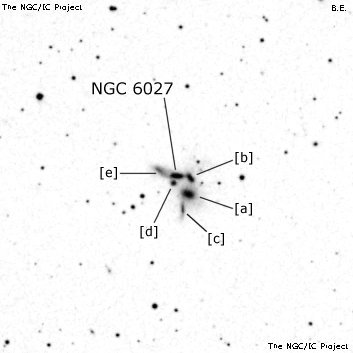NGC/IC Project Restoration Effort
(This is a very very beta version)
NGC6027


Basic Information
Location and Magnitude
Right Ascension: 15:59:12.5
Declination: +20:45:50
Constellation: SER
Visual Magnitude: 13.5
Historic Information
Discoverer: Stephan
Year of discovery: 1882
Discovery aperture: 31.0
Observational
Summary description: eF, vF * inv, 2 vF st nr
Sub-type: S0
Corwin's Notes
=====
NGC 6027 is the brightest galaxy in Seyfert's Sextet. There has been some
confusion about the designations for the six objects in the modern catalogues.
While they are fairly easy to sort out, I have retained the original letter
designations assigned by Carl Seyfert in his 1951 PASP paper, in spite of my
"rule" mandating positional notation in multiplets. Here is a case of
historical precedent overriding reason and common sense.
I also find it curious that Stephan saw only one of the galaxies here. As
well as NGC 6027 itself, Seyfert's "a" and "b" are probably bright enough to
be seen visually, especially in the 70-cm reflector that Stephan was using.
Note also that Hickson and a few others consider "e" to be simply a tidal
extension of N6027. This it may be, but I've retained the separate listing.
Steve's Notes
=====
NGC 6027
48" (5/15/12): the brightest components of Seyfert's Sextet were NGC 6027 = HCG 79b and NGC 6027A = HCG 79a. Both were moderately bright at 610x, though NGC 6027 was more elongated at 2:1 E-W, ~20"x10". NGC 6027E, a diffuse plume, was easily visible extending 30" NE and narrowing near the end where it brightens slightly. NGC 6027D = HCG 79e is situated barely off the south side and appeared faint, extremely small, round, 6" diameter. NGC 6027B = HCG 79c (third brightest member) is just 24" W and appeared fairly faint, small, oval 3:2 SW-NE, 18"x12". Finally NGC 6027C = HCG 79d is furthest south (fifth brightest) and appeared faint, fairly small, very elongated 4:1 N-S, ~25"x7", with a low, nearly even surface brightness.
18" (8/3/05): at 257x, the brightest component of Seyfert's Sextet appeared faint, very small, slightly elongated ~E-W, 15"x10", contains a faint stellar nucleus with direct vision. A mag 14.5 star lies 1' ESE and two additional mag 14.5 stars lie close SE. Just resolved from HCG 79c which lies 22" W of center.
18" (6/20/04): at 320x, a trio of galaxies forming a small equilateral triangle were fairly easily resolved with careful viewing. The brightest of the trio (HCG 79b) is at the NE corner and appeared elongated 3:2 E-W, ~20"x13". The other two members (HCG 79a and HCG 79c) are both extremely small, round, ~10" diameter. Two mag 14.5 stars 1'-1.5' SE are collinear with HCG 79b and a slightly brighter mag 14 star lies 2' W.
17.5" (5/14/88): faint, small, elongated ~E-W.
17.5" (6/6/86): this is Seyfert's Sextet = HCG 79, an extremely compact group! On close inspection, the confused "clump" resolves into three components with the brightest component (HCG 79b) appearing fairly faint, small. Extremely close are HCG 79a = NGC 6027A just 36" SSW and HCG 79c = NGC 6027B 22" W of center. A mag 14.5 star is 1.1' ESE and other faint stars are near. These three galaxies are just resolved at 220x.
13" (6/18/85): slightly elongated E-W.
13" (5/26/84): faint, very small, irregularly round, weak concentration.



